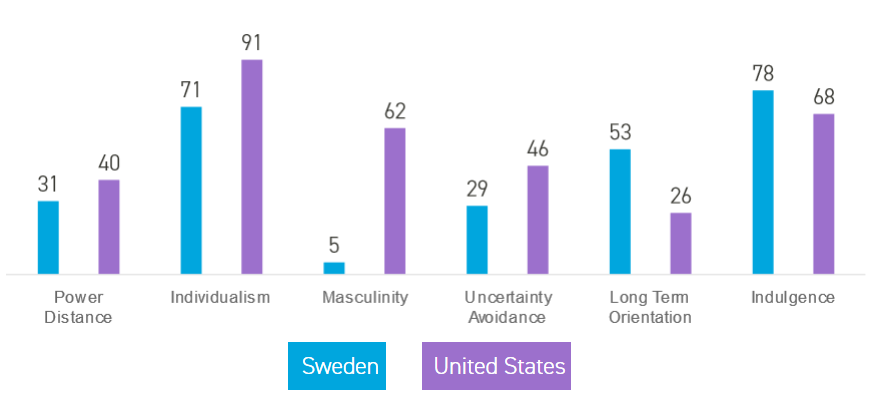Introduction
National cultural dimensions can significantly affect intercultural communication in the business context. When referring to the categories determined for the cultural analysis by Geert Hofstede, it is possible to explain the specifics of doing business in different national contexts (Barkley & Eggertsson, 2017). The purpose of this paper is to compare and contrast the United States and Sweden in terms of cultural dimensions and provide recommendations for organizations managing intercultural communication.
Similarities in the United States and Sweden
Figure 1 presents the comparison of the US and Sweden with reference to six cultural dimensions determined by Hofstede. According to the data provided by The Hofstede Centre, the cultures of the US and Sweden are similar in terms of Power Distance, Individualism, and Indulgence criteria (Hofstede Insights, 2020). Thus, a low Power Distance score for both countries means that the representatives of these cultures prefer to be independent, oriented toward equal rights and decentralized power. Management is supportive, and communication is usually direct and facilitating (Fors Connolly & Johansson Sevä, 2018).
High Individualism scores are associated with people’s focus on their personal needs, and they prefer to work and be managed individually. Furthermore, both societies represent the cultures of Indulgence that means Americans and Swedes prefer to realize their needs and desires to enjoy life and remain optimistic. Scores regarding Masculinity, Uncertainty Avoidance, and Long-Term Orientation are rather opposite.

Differences in the United States and Sweden
When contrasting scores on Masculinity, Uncertainty Avoidance, and Long-Term Orientation categories, it is possible to notice that Sweden is characterized as a Feminine society (score 5) with a focus on keeping work and life balance and the quality of life. Swedes are interested in finding consensus at work, flexibility, and feeling comfortable (Tian & Guang, 2017). For Americans living in a Masculine society (score 62), the orientation toward the development of a career, success, and monetary rewards is more important than finding balance.
Characteristics regarding Uncertainty Avoidance also differ as Swedes are more relaxed when focusing on their future, and Americans tend to avoid some uncertainty regarding their future. With reference to Long-Term Orientation, Swedes do not express a certain attitude toward this category (score 53) (Hofstede Insights, 2020). On the contrary, Americans represent a normative society for whom traditions are important, and changes can be resisted.
Recommended Solutions
To improve communication for the representatives of organizations from the US and Sweden working together, it is important to provide support for Swedes with the help of assigning a supportive team leader or manager. Furthermore, it is necessary to organize a schedule in a specific way to avoid overtime work on projects for Swedes. Contracts and terms developed to regulate the cooperation need to be actively discussed by the representatives of teams to achieve the consensus comfortable for Swedes and avoid uncertainty inappropriate for Americans (Kristjánsdóttir, Guðlaugsson, Guðmundsdóttir, & Aðalsteinsson, 2017). Much attention should be paid to communicating the importance of following norms for Americans (Baack, 2012). Positive results in communication will be achieved through accentuating similarities typical of Individualist societies.
Conclusion
On the one hand, the cultures of the US and Sweden are similar in terms of Individualism, Power Distance, and Indulgence. Thus, it is possible to effectively organize communication of individual employees with managers, promote equality, and avoid strict hierarchy. On the other hand, Swedes live in a highly Feminine society and Americans live in a highly Masculine society. As a result, their approaches to work and their goals differ significantly. This aspect needs to be taken into account when organizing the cooperation and professional communication between representatives of these cultures.
References
Baack, D. (2012). Management communication (10th ed.). San Diego, CA: Bridgepoint Education, Inc.
Barkley, D. L., & Eggertsson, M. (2017). Using Hofstede’s model to improve multicultural management in the European Union. Journal of International Management Studies, 17(1), 1-12.
Fors Connolly, F., & Johansson Sevä, I. (2018). Social status and life satisfaction in context: A comparison between Sweden and the USA. International Journal of Wellbeing, 8(2), 110-134.
Hofstede Insights. (2020). Country comparison. Web.
Kristjánsdóttir, H., Guðlaugsson, Þ. Ö., Guðmundsdóttir, S., & Aðalsteinsson, G. D. (2017). Hofstede national culture and international trade. Applied Economics, 49(57), 5792-5801.
Tian, K., & Guang, T. (2017). Exploration of collectivism in contemporary Sweden. The Journal of Applied Business and Economics, 19(11/12), 11-27.